

6 Nasty Drugs Your Meat Is On. February 7, 2014 | Like this article?
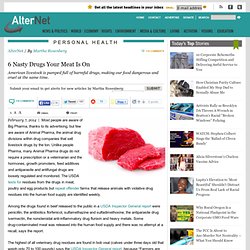
Join our email list: Stay up to date with the latest headlines via email. Most people are aware of Big Pharma, thanks to its advertising, but few are aware of Animal Pharma, the animal drug divisions within drug companies that sell livestock drugs by the ton. Unlike people Pharma, many Animal Pharma drugs do not require a prescription or a veterinarian and the hormones, growth promoters, feed additives and antiparasite and antifungal drugs are loosely regulated and monitored. Among the drugs found in beef released to the public in a USDA Inspector General report were penicillin, the antibiotics florfenicol, sulfamethazine and sulfadimethoxine, the antiparasite drug ivermectin, the nonsteroidal anti-inflammatory drug flunixin and heavy metals. Video: What Happens Inside Your Body When You Eat Processed Food. The Media Can Legally Lie. In February 2003, a Florida Court of Appeals unanimously agreed with an assertion by FOX News that there is no rule against distorting or falsifying the news in the United States.
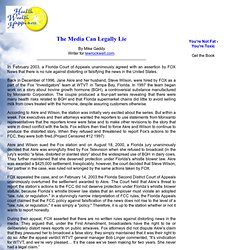
Back in December of 1996, Jane Akre and her husband, Steve Wilson, were hired by FOX as a part of the Fox “Investigators” team at WTVT in Tampa Bay, Florida. In 1997 the team began work on a story about bovine growth hormone (BGH), a controversial substance manufactured by Monsanto Corporation. The couple produced a four-part series revealing that there were many health risks related to BGH and that Florida supermarket chains did little to avoid selling milk from cows treated with the hormone, despite assuring customers otherwise.
Bowman v. Monsanto: Indiana Farmer’s Supreme Court Challenge to Corporate Control of Food Supply. » 13 Banned Foods Still Allowed In The U.S. By Cristina Goyanes, Shape You think the FDA has your back?
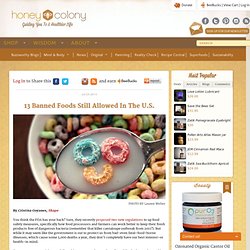
Sure, they recently proposed two new regulations to up food safety measures, specifically how food processors and farmers can work better to keep their fresh products free of dangerous bacteria (remember that killer cantaloupe outbreak from 2011?). But while it may seem like the government is out to protect us from bad–even fatal–food-borne illnesses, which cause some 3,000 deaths a year, they don’t completely have our best interest–or health–in mind.
“For numerous suspicious and disturbing reasons, the U.S. has allowed foods that are banned in many other developed countries into our food supply,” says nutritionist Mira Calton who, together with her husband Jayson Calton, Ph.D., wrote the new book Rich Food, Poor Food due out in February. Research: Gulf Shrimp Widely Contaminated With Carcinogens. Radioactive bluefin tuna crossed the Pacific to US. LOS ANGELES (AP) — Across the vast Pacific, the mighty bluefin tuna carried radioactive contamination that leaked from Japan's crippled nuclear plant to the shores of the United States 6,000 miles away — the first time a huge migrating fish has been shown to carry radioactivity such a distance.
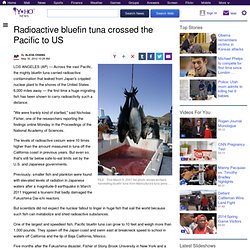
"We were frankly kind of startled," said Nicholas Fisher, one of the researchers reporting the findings online Monday in the Proceedings of the National Academy of Sciences. The levels of radioactive cesium were 10 times higher than the amount measured in tuna off the California coast in previous years. But even so, that's still far below safe-to-eat limits set by the U.S. and Japanese governments. Previously, smaller fish and plankton were found with elevated levels of radiation in Japanese waters after a magnitude-9 earthquake in March 2011 triggered a tsunami that badly damaged the Fukushima Dai-ichi reactors.
Eating Animals. Eating Animals is the third book by the American writer Jonathan Safran Foer, published in 2009.
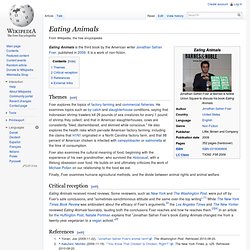
It is a work of non-fiction. Themes[edit] Foer explores the topics of factory farming and commercial fisheries. He examines topics such as by-catch and slaughterhouse conditions, saying that Indonesian shrimp trawlers kill 26 pounds of sea creatures for every 1 pound of shrimp they collect, and that in American slaughterhouses, cows are consistently "bled, dismembered, and skinned while conscious.
" He also explores the health risks which pervade American factory farming, including the claims that H1N1 originated in a North Carolina factory farm, and that 98 percent of American chicken is infected with campylobacter or salmonella at the time of consumption. Foer also examines the cultural meaning of food, beginning with the experience of his own grandmother, who survived the Holocaust, with a lifelong obsession over food. Critical reception[edit] References[edit] External links[edit]
Seven Million Pounds of “Pink Slime” Beef Destined for National School Lunch Program. "pink slime" burger?
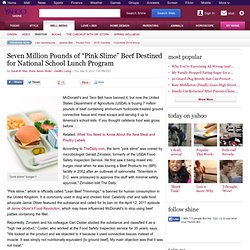
McDonald's and Taco Bell have banned it, but now the United States Department of Agriculture (USDA) is buying 7 million pounds of beef containing ammonium hydroxide-treated ground connective tissue and meat scraps and serving it up to America's school kids. If you thought cafeteria food was gross before…. Related: What You Need to Know About the New Meat and Poultry Labels According to TheDaily.com, the term "pink slime" was coined by microbiologist Gerald Zirnstein, formerly of the USDA Food Safety Inspection Service.
He first saw it being mixed into burger meat when he was touring a Beef Products Inc (BPI) facility in 2002 after an outbreak of salmonella. Say hello to mechanically separated chicken. It’s... Arsenic in Our Chicken?